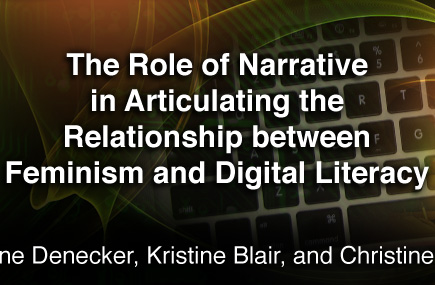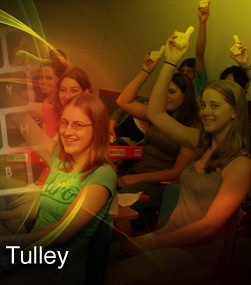Christine Tulley: Contradictory Identities/Rethinking Assumptions
An introductory gender studies course, ideally, offers an early opportunity for undergraduate students to articulate experiences that have helped shape their identities as gendered persons. In many gender studies courses, narratives from both the students and from the published texts they study play a key role in defining these experiences. In classes I teach for instance, students often read ethnographic studies of specific populations, for example, Jyoti Puri’s (1999) Woman, Body, Desire in Post-Colonial India: Narratives of Gender and Sexuality, and then craft their own narratives in response.
Narrative is typically used as one method of untangling a central conflict within gender studies – whether gender is biologically (i.e. “essentially”) or socially constructed—and serves as a tool to help reveal implications of each position. To sum up this debate, essentialism argues that “certain phenomena are natural, inevitable, and biologically determined,” and findings from genetic research and sociobiology are used to support essentialist positions (DeLamater and Hyde, 1998, p. 10; Irvine, 1990). In contrast, social constructionism argues reality is affected by social experiences and, more importantly for the study of narrative, “emphasizes language as an important means by which we interpret experience” (DeLamater and Hyde, 1998, p. 14).
If language is a potential tool to make sense of gendered experiences, the DALN provides a useful resource to explore how language and gender may or may not be linked and which phenomena can be linked to biology or society. Toward that end, two narratives in particular,"Writing about Boys" and "Music Story" are particularly useful because both female narrators describe how early dating experiences with boys shaped their literacy practices and, by association, their identities as gendered adults. Both narratives recount experiences with which both male and female students can identify: keeping a diary and making a mix tape (or in updated language, an iPod playlist) for a significant other. The mix tape has been cited as a method for teen girls to both produce and consume popular music as well as a method to construct an authentic “self” (Baker, 2001). Because both narrators interact with and represent their teen selves, these narratives also demonstrate how the literate self can be layered with each retelling (Järvinen, 2004).
"Writing about Boys" Video File
(transcript)
Moreover, both narrators question whether their literacy practices can be considered feminist when male influence is the catalyst, as this clip from Rohan illustrates:
In this excerpt, Rohan realizes the contradiction of telling a literacy story that is largely about someone else’s literacy practices—in this case an ex-boyfriend named Dave. Her recognition of the irony of using a space where she is invited to focus on herself to instead describe her boyfriend’s actions serves as a useful case study for studying third wave feminism—a movement “defined by contradiction” (Heywood & Drake, 1997a, p. 8). In this movement, women are confronted with both the early feminist project to “revalue typically ‘feminine’ qualities and make them socially desirable for both women and men” (Cox, Johnson, Newitz, & Sandell, 1997, p. 178) and at the same time encouraged to embrace “power feminism” where “whining” about gender inequities is discouraged and competition and achievement are encouraged (Heywood & Drake, 1997b, p . 50).
Students recognize not only that Rohan subverts her own narrative by recounting Dave’s but also that she competes with her ex-boyfriend, noting that his book was published first. The tensions between traditional female characteristics (e.g., cooperative and supportive) and non-traditional ones (e.g., competitive) surface in this DALN narrative through not only Rohan’s contradictory words but also her body language and facial expressions. She looks wistful as she talks about Dave, but a hard edge to her voice emerges when she describes her competitiveness with him.
Both DALN narratives described above can provide rich material for class discussion in this context because they illustrate how some literacy narratives manifest both biological markers and social situations at the same time. Literacy narratives are told in social situations (to an interviewer, to an unknown audience) and are typically about how literacy developed in reaction to some social stimulus such as an early romantic relationship or an experienced marked by race as Chris Denecker notes. Both narrators, for example, grapple with the role of early male literacy mentors, and both women mention potential effects these males had on their lives as gendered persons.
At the same time, biology is clearly present in both the subject matter (sexual attraction) and the construction of these narratives. As Tulley (2010) has argued elsewhere, “The flaws of the human voice, if not edited out and cleaned up serve as an asset…the voice lends an aura of authenticity to the communication.” Stuttering, asides, and blurred speech all remind listeners of the gendered body. When these elements are edited out, as listeners may suspect of Panter’s “Music Story,“ the end results may not seem as gendered. Panter’s voice is smooth like honey and the complete absence of narrative ticks such as “um” seemed to some students to be unnatural (and, as one astute student noted, such editing might be Panter’s attempt to socially construct her identity in a particular way). In contrast, Liz Rohan’s “Writing about Boys” narrative features her physical body, facial gestures, etc. Because it is an unedited video, it also retains all facial and vocal ticks, lapses in thought, and stutters.
The end result is that literacy narratives, illustrated by these representative examples, complicate and reveal ruptures in the essentialism vs. constructionism debate for students in introductory gender studies courses, making these recordings from the DALN useful tools for exploring the role of feminism. In short, literacy narratives manifest the actual debate. They provide an occasion for students to ask: Is it okay to gain a new form of literacy practice from relationships with males? And can the outcome of such literacies possibly be feminist or foster equality between men and women?


